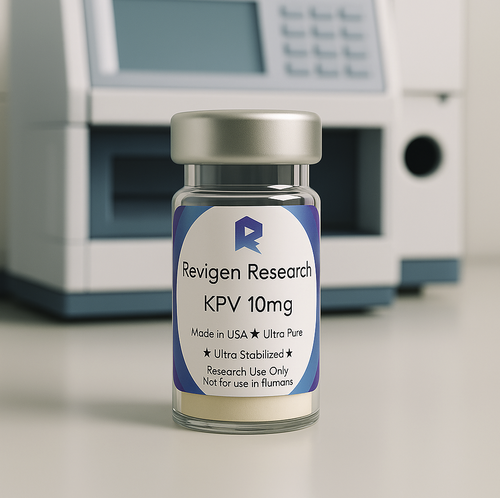Product Specifications: Lyophilized Powder (>99% purity) in 3ml vial. *Requires Reconstitution ** Available for bulk custom order with 57 Cap/Crimp colors to choose from.
Application: Research peptide evaluated in fat reduction, cardiovascular health, Anti-cancer, fertility, mood and behavior improvement
Chemical Formula: C63H83N17O14
CAS Number: 374675-21-5
Molecular Weight: ~1302.4 g/mol
Concentration: ≥99%
Kisspeptin-10 is derived from the 145-amino acid precursor polypeptide encoded by the KISS1 gene, which is further processed to shorter fragments. Among these, the 10-amino acid kisspeptin-10 preserves the full biological activity of longer kisspeptin forms while offering advantages like a shorter half-life and more rapid onset of action 1. These characteristics make kisspeptin-10 particularly valuable for both research and potential therapeutic applications.
Originally discovered as a regulator of cancer metastasis, kisspeptin was later identified as a potent regulator of hypothalamic gonadotropin-releasing hormone (GnRH) activity. Since then, researchers have uncovered multiple physiological roles for kisspeptin-10, expanding its potential applications significantly.
Reproductive Health Applications
Regulation of Gonadotropin Secretion
Kisspeptin-10 is being extensively researched for its role in reproductive health due to its ability to stimulate GnRH secretion, which in turn triggers the release of luteinizing hormone (LH) and follicle-stimulating hormone (FSH). Studies have demonstrated that intravenous bolus administration of kisspeptin-10 results in a rapid and dose-dependent rise in serum LH concentration in men. Furthermore, continuous infusion of kisspeptin-10 increases testosterone levels, LH pulse frequency, and pulse size.
Treatment of Reproductive Disorders
Research is exploring kisspeptin-10's potential in treating various reproductive disorders, including:
- Hypogonadotropic Hypogonadism: Studies suggest that kisspeptin administration could help restore fertility in individuals with this condition.
- Hypothalamic Amenorrhea: Kisspeptin-10 is being investigated for treating this condition where menstruation stops due to energy imbalance.
- Polycystic Ovary Syndrome (PCOS): Research indicates potential therapeutic applications for women with PCOS.
Assisted Reproduction Technology
Kisspeptin-10 shows promising applications in assisted reproduction, particularly:
- In Vitro Fertilization (IVF): Research demonstrates that kisspeptin can be used as a trigger for oocyte maturation during IVF treatments.
- Oocyte Fertilization and Maturation: Studies are examining kisspeptin's role in follicle development and oocyte fertilization.
Sexual Behavior Modulation
Recent research has expanded into kisspeptin's effects on sexual behavior:
- Hypoactive Sexual Desire Disorder: Emerging research explores kisspeptin's role in regulating sexual behavior and its potential for treating hypoactive sexual desire disorder.
- Brain Processing of Sexual Stimuli: Studies show that kisspeptin administration modulates sexual and attraction brain processing in functional neuroimaging.
Cancer Treatment Applications
Anti-Metastatic Properties
Kisspeptin-10 was initially identified as a metastasis suppressor, and current research continues to explore this important property:
- Inhibition of Cancer Cell Migration: Studies show that kisspeptin-10 inhibits the migration of various cancer cells, including breast cancer cells, by regulating epithelial-mesenchymal transition.
- Multiple Cancer Types: Research demonstrates kisspeptin-10's inhibitory effects on breast, ovarian, prostate, colorectal, melanoma, and endometrial cancers.
Mechanisms of Anti-Cancer Action
Several mechanisms have been identified through which kisspeptin-10 exerts its anti-cancer effects:
- Cell Cycle Regulation and Apoptosis: Kisspeptin-10 regulates cell cycle progression and induces apoptosis in cancer cells.
- MMP-9 Expression Inhibition: In colorectal cancer, kisspeptin treatment inhibits cancer cell migration and invasion by blocking MMP-9 expression.
- CXCR4 Signaling Antagonism: Kisspeptin-10 antagonizes CXCR4-mediated signaling, which plays a role in directing organ-specific metastasis.
- EIF2AK2 Signaling: Research suggests that kisspeptin represses cancer metastasis via EIF2AK2 signaling pathway.
- SIX1/Wnt/β-Catenin Pathway: Studies show kisspeptin-10 inhibits the proliferation, migration, and stemness of esophageal cancer cells by regulating this pathway.
Metabolic Disorder Applications
Glucose and Lipid Metabolism Regulation
Kisspeptin-10 is being investigated for its effects on metabolic processes:
- Type 2 Diabetes: Research suggests a potential role for kisspeptin in regulating glucose metabolism and treating type 2 diabetes.
- Obesity Management: Studies indicate that impaired kisspeptin signaling decreases metabolism and promotes glucose intolerance and obesity, suggesting therapeutic potential for kisspeptin-10.
Adipose Tissue Function
Research has revealed kisspeptin-10's effects on adipose tissue:
- Lipogenesis and Adipogenesis: Studies show that kisspeptin decreases lipogenesis, adipogenesis, and 3T3-L1 cell proliferation while increasing lipolysis 41.
- Energy Expenditure: Kisspeptin signaling regulates body weight and energy expenditure.
Metabolic-Associated Fatty Liver Disease (MAFLD)
Research is exploring kisspeptin's role in the pathogenesis and potential treatment of metabolic-associated fatty liver disease.
Cardiovascular Applications
Vascular Tone Regulation
Recent research has revealed significant roles for the kisspeptin system in cardiovascular disease, particularly in vascular tone regulation.
Atherosclerosis
Studies are investigating kisspeptin's potential role in preventing or treating atherosclerosis.
Neuroendocrine Applications
Mood and Behavior
Kisspeptin-10 appears to be involved in the modulation of mood and behavior.
Angiogenesis
Research suggests that kisspeptin-10 facilitates angiogenesis, which has implications for various physiological and pathological processes.
Renal Function
Studies indicate that kisspeptin-10 plays a role in regulating renal function.
References:
Ohtaki, T., Shintani, Y., Honda, S., Matsumoto, H., Hori, A., & Masuda, Y. (2001). Metastasis suppressor gene KiSS-1 encodes peptide ligand of a G-protein-coupled receptor. Nature, 411(6842), 613-617.
Muir, A. I., Chamberlain, L., Elshourbagy, N. A., Michalovich, D., Moore, D. J., Calamari, A., ... & Chambers, J. K. (2001). AXOR12, a novel human G protein-coupled receptor, activated by the peptide KiSS-1. Journal of Biological Chemistry, 276(31), 28969-28975.
Dhillo, W. S., Chaudhri, O. B., Patterson, M., Thompson, E. L., Murphy, K. G., Badman, M. K., ... & Bloom, S. R. (2005). Kisspeptin-54 stimulates the hypothalamic-pituitary-gonadal axis in human males. Journal of Clinical Endocrinology and Metabolism, 90(12), 6609-6615.
Disclaimer: This product is intended solely for laboratory research purposes. It is not suitable for consumption by humans, nor for medical, veterinary, or household purposes. Researchers should handle all peptides with care and adhere to strict safety guidelines during experiments. Only qualified professionals with appropriate expertise should manage and handle this product. The distributor, manufacturer, and seller of this product are not responsible for misuse or any resulting consequences. By accessing this product, you consent to comply with these terms and conditions.






